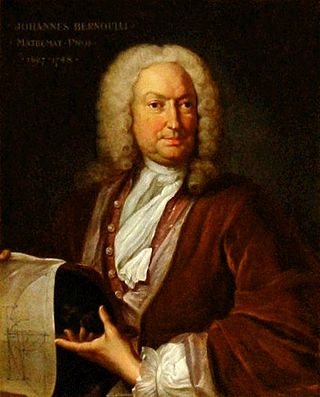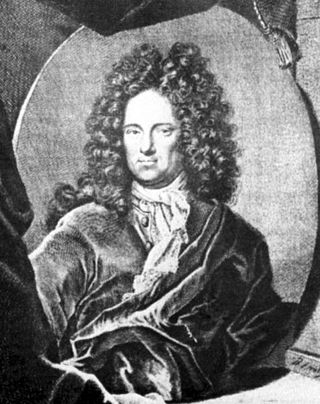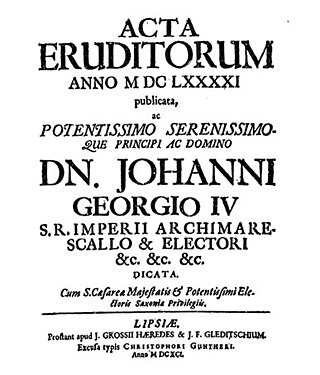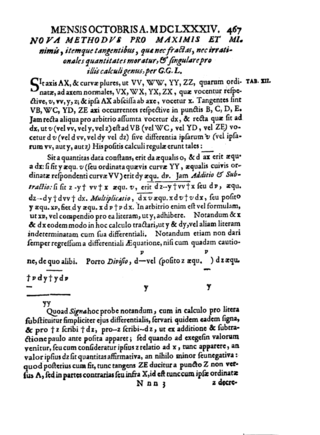
Gottfried Wilhelm (von) Leibniz was a German polymath active as a mathematician, philosopher, scientist and diplomat. He is a prominent figure in both the history of philosophy and the history of mathematics. He wrote works on philosophy, theology, ethics, politics, law, history and philology. Leibniz also made major contributions to physics and technology, and anticipated notions that surfaced much later in probability theory, biology, medicine, geology, psychology, linguistics and computer science. In addition, he contributed to the field of library science by devising a cataloguing system whilst working at Wolfenbüttel library in Germany that would have served as a guide for many of Europe's largest libraries. Leibniz's contributions to a wide range of subjects were scattered in various learned journals, in tens of thousands of letters and in unpublished manuscripts. He wrote in several languages, primarily in Latin, French and German, but also in English, Italian and Dutch.

Leonhard Euler was a Swiss mathematician, physicist, astronomer, geographer, logician and engineer who founded the studies of graph theory and topology and made pioneering and influential discoveries in many other branches of mathematics such as analytic number theory, complex analysis, and infinitesimal calculus. He introduced much of modern mathematical terminology and notation, including the notion of a mathematical function. He is also known for his work in mechanics, fluid dynamics, optics, astronomy and music theory.

Jacob Bernoulli was one of the many prominent mathematicians in the Bernoulli family. He was an early proponent of Leibnizian calculus and sided with Gottfried Wilhelm Leibniz during the Leibniz–Newton calculus controversy. He is known for his numerous contributions to calculus, and along with his brother Johann, was one of the founders of the calculus of variations. He also discovered the fundamental mathematical constant e. However, his most important contribution was in the field of probability, where he derived the first version of the law of large numbers in his work Ars Conjectandi.

In physics and mathematics, a brachistochrone curve, or curve of fastest descent, is the one lying on the plane between a point A and a lower point B, where B is not directly below A, on which a bead slides frictionlessly under the influence of a uniform gravitational field to a given end point in the shortest time. The problem was posed by Johann Bernoulli in 1696.

Johann Bernoulli was a Swiss mathematician and was one of the many prominent mathematicians in the Bernoulli family. He is known for his contributions to infinitesimal calculus and educating Leonhard Euler in the pupil's youth.

In calculus, Leibniz's notation, named in honor of the 17th-century German philosopher and mathematician Gottfried Wilhelm Leibniz, uses the symbols dx and dy to represent infinitely small increments of x and y, respectively, just as Δx and Δy represent finite increments of x and y, respectively.
Calculus, originally called infinitesimal calculus, is a mathematical discipline focused on limits, continuity, derivatives, integrals, and infinite series. Many elements of calculus appeared in ancient Greece, then in China and the Middle East, and still later again in medieval Europe and in India. Infinitesimal calculus was developed in the late 17th century by Isaac Newton and Gottfried Wilhelm Leibniz independently of each other. An argument over priority led to the Leibniz–Newton calculus controversy which continued until the death of Leibniz in 1716. The development of calculus and its uses within the sciences have continued to the present day.

Nicolas Fatio de Duillier was a mathematician, natural philosopher, astronomer, inventor, and religious campaigner. Born in Basel, Switzerland, Fatio mostly grew up in the then-independent Republic of Geneva, of which he was a citizen, before spending much of his adult life in England and Holland. Fatio is known for his collaboration with Giovanni Domenico Cassini on the correct explanation of the astronomical phenomenon of zodiacal light, for inventing the "push" or "shadow" theory of gravitation, for his close association with both Christiaan Huygens and Isaac Newton, and for his role in the Leibniz–Newton calculus controversy. He also invented and developed the first method for fabricating jewel bearings for mechanical watches and clocks.

Guillaume François Antoine, Marquis de l'Hôpital, also known as Guillaume-François-Antoine Marquis de l'Hôpital, Marquis de Sainte-Mesme, Comte d'Entremont, and Seigneur d'Ouques-la-Chaise, was a French mathematician. His name is firmly associated with l'Hôpital's rule for calculating limits involving indeterminate forms 0/0 and ∞/∞. Although the rule did not originate with l'Hôpital, it appeared in print for the first time in his 1696 treatise on the infinitesimal calculus, entitled Analyse des Infiniment Petits pour l'Intelligence des Lignes Courbes. This book was a first systematic exposition of differential calculus. Several editions and translations to other languages were published and it became a model for subsequent treatments of calculus.

The Dissertatio de arte combinatoria is an early work by Gottfried Leibniz published in 1666 in Leipzig. It is an extended version of his first doctoral dissertation, written before the author had seriously undertaken the study of mathematics. The booklet was reissued without Leibniz' consent in 1690, which prompted him to publish a brief explanatory notice in the Acta Eruditorum. During the following years he repeatedly expressed regrets about its being circulated as he considered it immature. Nevertheless it was a very original work and it provided the author the first glimpse of fame among the scholars of his time.
Carpzov is the name of a family, many of whose members attained distinction in Saxony in the 17th and 18th centuries as jurists, theologians and statesmen.

In the history of calculus, the calculus controversy was an argument between the mathematicians Isaac Newton and Gottfried Wilhelm Leibniz over who had first invented calculus. The question was a major intellectual controversy, which began simmering in 1699 and broke out in full force in 1711. Leibniz had published his work first, but Newton's supporters accused Leibniz of plagiarizing Newton's unpublished ideas. Leibniz died in disfavor in 1716 after his patron, the Elector Georg Ludwig of Hanover, became King George I of Great Britain in 1714. The modern consensus is that the two men developed their ideas independently.
In classical mechanics, Maupertuis's principle states that the path followed by a physical system is the one of least length. It is a special case of the more generally stated principle of least action. Using the calculus of variations, it results in an integral equation formulation of the equations of motion for the system.

Otto Mencke was a 17th-century German philosopher and scientist.

A timeline of calculus and mathematical analysis.
Martin Knutzen was a German philosopher, a follower of Christian Wolff and teacher of Immanuel Kant, to whom he introduced the physics of Isaac Newton.

Ehrenfried Walther von Tschirnhaus was a German mathematician, physicist, physician, and philosopher. He introduced the Tschirnhaus transformation and is considered by some to have been the inventor of European porcelain, an invention long accredited to Johann Friedrich Böttger but others claim porcelain had been made by English manufacturers at an even earlier date.

Johann Friedrich Gleditsch was a major book publisher in the late 17th and early 18th centuries.

Joseph Ehrenfried Hofmann was a German historian of mathematics, known for his research on Gottfried Wilhelm Leibniz.

"Nova Methodus pro Maximis et Minimis" is the first published work on the subject of calculus. It was published by Gottfried Leibniz in the Acta Eruditorum in October 1684. It is considered to be the birth of infinitesimal calculus.
















